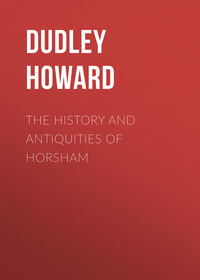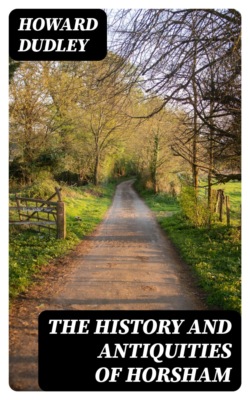Kitabı oku: «The History and Antiquities of Horsham», sayfa 5
In the chancel is a mural monument to the memory of Richard Wheatly gent, ob. 1668, and some members of his family, who were nearly allied to the Mitchells of Field place. There is also another inscription to the memory of the Rev. Alexander Hay, former rector of the parish, 1724, also several of his children. Dallaway mentions that after the Scotch rebellion in 1715, some of the attained persons took refuge in the woods of Itching field, and were permitted to reside with their countryman Alexander Hay; indeed we can hardly imagine a more suitable place for concealment, than the parsonage house, situated as it was at that time, in the centre of a dense forest, through which there was hardly any passable road.
The last monumental inscription is for the Rev. Thomas Lavender a most exemplary minister of this parish, for upwards of 60 years, he died in the year 1776, at the age of 86.
The font is modern, but particularly neat and handsome; one of a very ancient description, was lately dug up in the churchyard.
Proceeding along the turnpike road to the west of Horsham and passing Farthing Bridge, of which the annexed wood-cut is a representation, we reach Broad-bridge Heath, a delightful, picturesque, and salubrious plain, so called: by pursuing the centre road, the visitor will arrive at Stroud, a small hamlet about 3 miles from Horsham; it is chiefly remarkable for the elegant residence denominated Stroud park, belonging to – Commerell esq.: the grounds around the house particularly deserve attention, and the sweetly retired situation of the fishing house, erected upon the banks of a lake surrounded by the majestic and noble trees for which this district is so justly celebrated, whilst the deep silence which pervades the whole, interrupted only by the rippling stream beneath, and the delightful choir of the feathered songsters, combine to render it, in every sense of the word, a most enchanting and delightful scene.
By taking the road to the left hand, on Broad-bridge heath, and again turning to the right at Lion’s Corner gate, the village of Slinfold, to which the hamlet of Stroud belongs, soon appears in sight. “Fold” observes Mr. Dallaway, “is a termination frequently belonging to parishes within the weald and in distinction to Hume seems to be applied to those which were first cultivated in square inclosures, after the removal of timber and underwood. This observation belongs to the early Saxon æra; and it is evident that the name of almost every vilor or farm within the district is derived from them.” The church build at the end of the village, was erected at the formation of the parish by bishop Ralph in 1230. It has a nave and north aisle with a small sepulchral chapel appendant. In this portion of the church which belongs to the manor of Dedisham, is a curiously sculptured female figure, destitute of any inscription, but traditionally said, to belong to a member of the family of Tregoz. – There are also two other mural monuments, with small painted alabaster effigies of women in the ancient dress of their times. The first of which we give a sketch, appears particularly “en bon point,” and is represented kneeling on a cushion, in the act of prayer. The following inscription, now almost illegible, appears beneath.
The remaining monument is to the memory of mistress Jane Blount, ob. 1614.
In the pavement is a large slab of Sussex marble, with an inscription to the memory of Richard Bradbridge gent., and Denys his wife, with their children, ob. 1633.
The tower is massive, and like all those in the Weald, surmounted by a spire of shingles, supported upon four upright beams of a length and diameter very seldom seen.
This parish which is bounded on the east by Warnham, west by Rudgewick and Billinghurst, north by Rudgewick, and south by Itchingfield, approaches nearer in form to a circle than any other, and is intersected in several directions by 3 turnpike roads. From the excellent slate quarries in the vicinity, slabs containing 100 square feet, and about 5 in thickness have often been raised. Several rare botanical plants are found in this parish, some indigenous, and others originally introduced by Dr. T. Manningham a former rector, well versed in that science.
The late eminent antiquary Mr. Warton, observes in his history of Kiddington, page 65, “About 5 years ago, (1775) on the edge of a lane in the parish of Slinfold in Sussex, four miles from Horsham, I saw several deep fissures in the Stane street, a Roman road, going from Arundel, if not from the sea side through Dorking to London. The dorsum not intended for heavy carriages consists of sea gravel and sea pebbles abounding on the Sussex coast, above 3 feet deep, and 7 yards long: these minute materials must have been amassed with prodigious labour.
Springfield, a handsome brick mansion to the north of the town, is the property of Francis Scawen Blunt esq., who now rents it to – Thornton Esq.
INNS AT HORSHAM

COACHES
Coaches pass daily to and from London, Brighton, Worthing, Windsor, Oxford, and Reading. – The Horsham and London Star Coach leaves the Swan inn West Street, at 7 o’clock every morning, and reaches the old Bell inn Holborn about a quarter to 12: from thence it starts the same afternoon, at a quarter past 3, and arrives at Horsham by 8.
GAS
The streets are now well lighted with gas, considering that this is the first year of their illumination. The gameter is erected at the back of Albion Terrace, another specimen of the improving state of the town. The good people of Horsham have lately been much annoyed by the dirty condition of their streets, occasioned by the insertion of the gas pipes, even to such an extent as almost to merit the ancient epithet of the county, as we find in a very old verse, or rather ryhme of the peculiarities of each shire.
Essex ful of good hoswifes
Middlesex ful of shyves,
Kentshire hoot as fyre,
Sussex ful of dyrt and myre.


